NEWSPAPER REPORT IN THE BACCHUS MARSH EXPRESS – Courtesy of Trove.
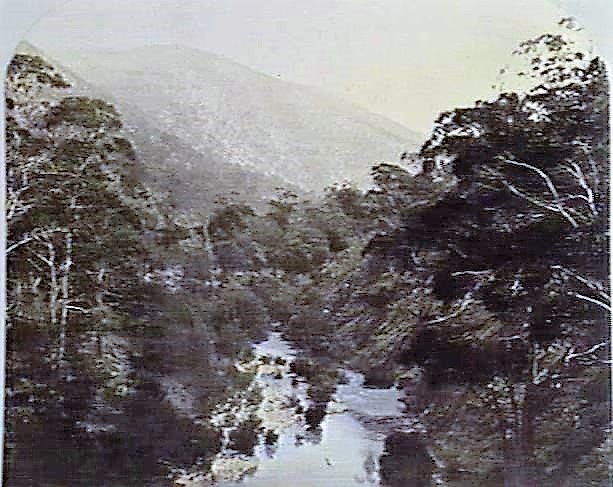
Lerdererg Gorge courtesy of the State Library.
Courtesy of Margot Hitchcock, Historian for the Blackwood & District Historical Society and Paul Kukiel..
“Early Blackwood” and the first discovery of gold there.
Bacchus Marsh Express (Vic.), Saturday 23 June 1928, page 4 (Courtesy of Trove)
Blackwood Diggings. To the Editor of the “Express.”
Sir,—Following upon the publication of my letter, headed “‘Blackwood Diggings,” which appeared in “The Argus,” of 17th September last, Mr. D. G. Stobie, of 34 Queen Street, Melbourne, entered into correspondence with me on the subject. Mr. Stobie is the eldest son of the late David Grieve Stobie, who played an important part in the affairs of “Early Blackwood,” and was, for many years subsequently, Secretary and Superintendent of the Melbourne Benevolent Asylum. As you republished an article on Blackwood, by “G.B.,” which appeared in “The Argus” of 20th August, 1927, and my letter above referred to, you may, perhaps, grant space to what Mr. Stobie has to say on the subject of “Early Blackwood” and the first discovery of gold there, and, in that hope, I give below s synopsis of his letters to me, bodying all he has to say on the subjects referred to.
Ballan, June 8th, 1928. I have read your contribution of 12th Sept. re “Blackwood Diggings.” There are numerous versions of this. (1) In “Smith’s Weekly,” 26th July. 1924, there is a long account of its discovery, in 1855, by Ted Hill, who received the Government bonus of £300, some years later. (2) There is the account of “G.B.,” 20th August last. (3) Tour own above referred to; all of which carry very considerable weight. My late father went to Blackwood in 1857, following the late Warden, Mr. Shuter. There was, however, a break between which I cannot, strange to say, fill in. I think a Mr. Gustave was in charge, as Clerk of the Courts. We lived in a house at the foot of Bald Hill, Golden Point, for 10 years. I was born in Melbourne, in February, 1857. I have a fairly clear memory, dating from 1864, when Blackwood was going strongly. A Mr. Croker is the only living one, at any rate, at Blackwood, who can go back to an earlier date. He remembers John Graham, of Greendale, driving his team down the Bald Hill.
There was a blazed track from Greendale originally, and another one coming from Mount Blackwood, and these joined at what was known as the Four Mile. Again, at the Two Mile the bye-track to Golden Point branched into three parts—one coming down Jackson’s Gully, another^ down the Bald Hill, .and the third to Jonas’s store. The main track continued then through Red Hill (Simmons’s and Barry’s Reefs on its left) to Kyneton. From the reservoir at Simmons’s Reef, all down the creek to below Mount Blackwood, there were little settlements, and from Mount Blackwood numerous side-tracks. One known as the Frenchman’s Track is in good order to-day. There were no made roads at all, but the traffic followed the summits or ridges of the hills, through the bush, after a primitive fashion. Later, corduroy, much still in evidence, was the order of the day, and at the Two Mile there are still one or two of the old blazed trees. Cann had a big hotel and store below the Two Mile, at Kangaroo Flat. Johnnie Cann, the son, drove the Blackwood coach, and was as well-known at Blow’s Flat, Pentland Hills, Ballan and Greendale, until about 1877, as at his own home. As a boy the height of my ambition was to have an appointment like Johnnie Cann’s.
In 1864,1 went to stay with a Captain Kane, who had a home three-and-a-half miles below Golden Point, at the mouth of Clear Water. Kane had an alluvial claim, and, among others boarding with him, I met Blathering Ned, Bill Warbreck, Red Bill and Jack Burns, all great men, to my boyhood’s idea.
In particular, I wish to name now a man named Ned Dearn, or Durn, whom we all understood to have been the discoverer of gold in Jackson’s Gully at any rate, to this day he has credit for it. Ned Dearn has gone to the “long home,” and it is a far cry from 1854 to now, but, to the Blackwood of old, and any of its people still surviving, he had and has the credit. I looked up an old manuscript, which I may complete, some day, for my own family, and in it I found an entry that gold was discovered, in 1853, by Ned Durn. The authority for this statement I cannot now locate. My late father had all the Scottish dislike to any malobservance of the Sabbath, but, in that day, miners would come up from 10 to 12 miles, and Sunday was a riotous day.
The Common Schools were carried on then, long before the present State system was established. On Sundays the Chinese Camp was always very lively. Everyone then had a flock of goats. Only after many years of burning and felling of timber could cattle come in at all. Entertainments in those days were very frequent, even when local talent had to be relied on. We had, of course, every nationality under the sun. Our tastes were simple, and the community generally lived very peaceably. On Boxing and New Year’s Days we had the usual jollifications. I heard as much broad Scotch, and saw as much snow, at Blackwood as I did nearly four years spent in Scotland. Blackwood would have delighted Charles Dickens, we had so many “characters.” Some had drifted up there in the early days and could never get away.
Among the old identities was a certain Scot, living at Sardine, who was one of the earliest to arrive on the field, and until the time of his death, 60 years later, had never been 20 miles from the spot. Other “spots” were his weakness. He came from a good family in the west of Scotland, and his real name was unknown’ save to a few. Campbellton and Fettercairn were the habitats of his people. His Scotch was too broad, even for me, at times. I could follow the “Aye o’ the lum,” and “Twa caulves ahint her,” but the higher intricacies were too much for me.
Sardine is the next big stream Clear, Water, coming in from the Kyneton side, about five miles from Golden Point. The Reservoir, Clear Water and Sardine are part and parcel of the Lerderderg. Blackwood had plenty of ready cash in its early days, and there was constant stream, more especially on Saturdays, from Greendale and Mount Blackwood, with poultry, pigs and dairy produce; and, of course, when three or four butchers became established, there was a good cattle market. Now the scene is changed. There is not one on the creek. Simmon’s Reef, Back Creek, Yankee Reef, without a soul, all deserted! Golden Point practically deserted, no land around it, not a” mine working, only the “Everlasting Hills” in evidence. Even through the hills and ranges, where in old days goats ranged by hundreds and hundreds, and later stray .wild cattle, one may walk all day without detecting a sign of animal life. Cann’s paddock at Breakneck, Kangaroo Flat, the last time I saw it, not very long ago, was as bare as a billiard table. It was once a very lively resort for “down the creek people” on their way home. Gold mining, like the stage coach and sailing vessel, is a memory of the past. Gold, however, in its discovery, gave us our first big move.
So far, Mr. Stobie’s very interesting narrative, and in respect of that part of it relating to the original discovery of gold at Blackwood, I desire to say: As to Mr. Stobie’s statement’ that a manuscript in his possession contains the information that gold was discovered at Blackwood by Ned Durn, in 1853, it is to be regretted that the authority for this statement cannot be found, because, if it be true, it certainly shows a discovery prior to the one of which Harry Densley gave me particulars. The country, in 1853, was in the hands of the pastoralists, the site of Blackwood being part of Sir John Lewes Pedder’s Cutumnimnip run (which, two years later, was acquired by Mr. Thomas Hamilton, and was subsequently re-named Glen Pedder), and it is possible that nuggets might have been picked up by some of thie employees engaged in looking after live stock. It is also possible, as a result of the gold discoveries, prospectors were roaming the country in search of fresh finds, and Durn may have been one of them. For instance gold was discovered at, Jim Crow’s (Daylesford) not very far from Blackwood, in 1852. I think, however, that in the then state of the country, anyone venturing into the intricate hills and gullies of the Dividing Range, unless he had first fixed upon a base to which he could return for food and equipment, would be taking a tremendous risk. When in Melbourne recently, I went to the Public Library, and searched the files of “The Argus” for the last quarter of 1854, and Brough Smyth’s “Goldfields and Mineral Districts of Victoria.” I found no reference of any kind to Blackwood in “The Argus” files, and in Brough Smyth’s work (though it was not stated when gold was first discovered at Blackwood, the date of its first discovery at Egerton was given), I found in a list given of nuggets the following: Mount Blackwood, 1851, 61b. 6oz. 19awt. 6grains; 1855, 201b. Ooz. 18 dwt. 0 grains; 1855, 31b. 8oz ll dwt 0 grains; 1855, 01b. ll oz. 3dwt. 11 grains. The authority for these statements is not given, but I imagine they were taken from the reports of the early mining surveyors, and whether the surveyors saw these nuggets themselves, or received accounts of them, more or less legendary, I am unable to say. The 1855 ones I believe to be genuine, because mining was going on at Blackwood at that time, but I should like to have further evidence in respect of the 1851 one. It would seem, if such a nugget were discovered at that time, and if Durn made a discovery in 1853, that they must have been isolated discoveries, because it is evident that the localities of the finds could not be worked for any length of time without others becoming aware of it. The late Mr. Thomas Macgillivray formed me, many years ago, that he took part in the first Blackwood rush, and that it occurred in 1855. Again, Mr. Stobie says that it was a common belief among early Blackwood people that Ned Durn first discovered gold there, in Jackson’s Gully.
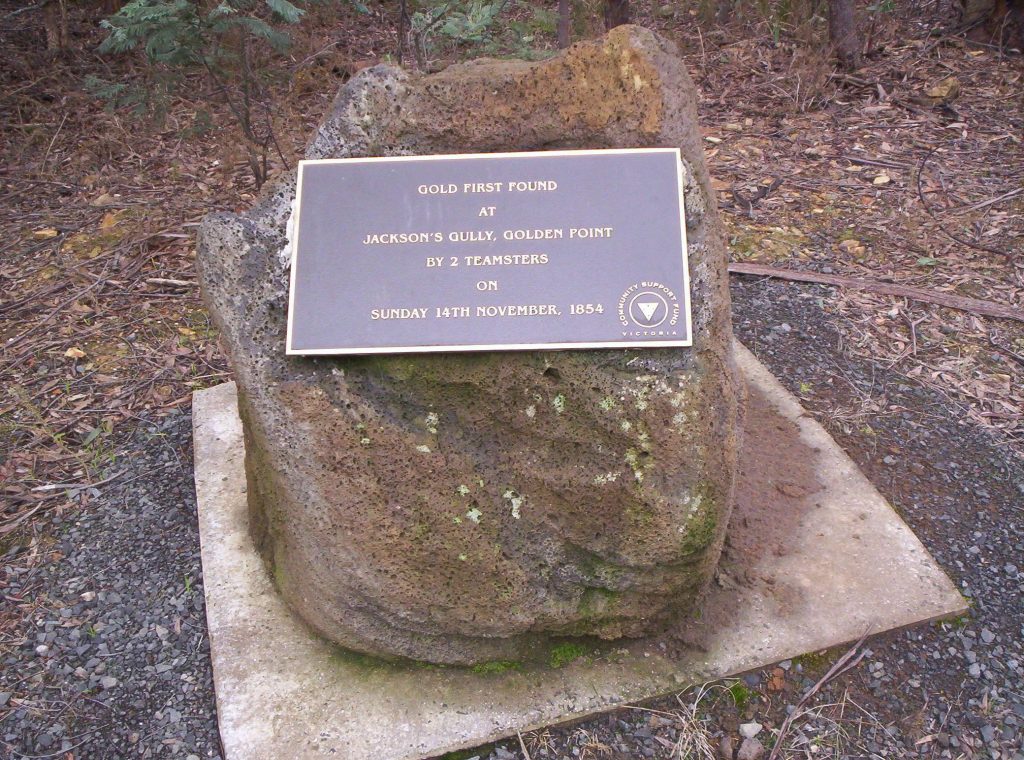
Marker that was where gold was first found at Jacksons Creek, Blackwood in November 1854.
If the gully had that name, at the time of Durn’s discovery, it is evident it must have been given to it by someone prior to that event taking place, and, as Harry Densley informed me that the gully was named after a man named Jackson one of Athorn and Hider’s original prospectors, if it bore that name at the time of Durn’s discovery, Densley’s statement is thereby corroborated.
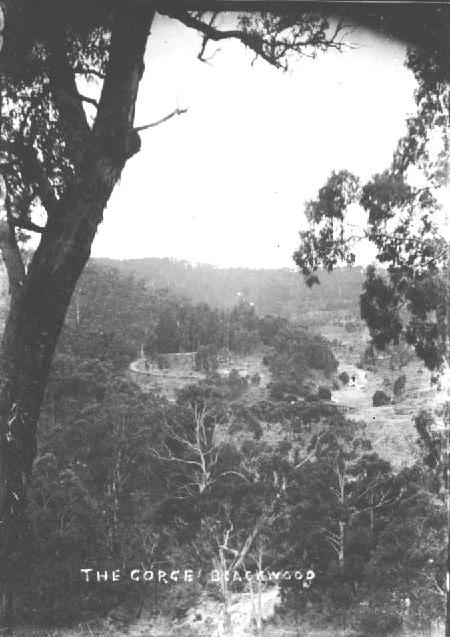
The Gorge, Blackwood from Sweets Lookout, Blackwood
John Drayton (“Smith’s Weekly”) is mistaken in his statement, “The Mount Blackwood field was discovered by Ted Hill, in the golden year of 1851, and his claim was acknowledged by the Government, which paid him a discoverer’s reward of £300 in 1863.” Brough Smyth’s work, hereinbefore mentioned, shows that Ted Hill’s reward was in respect of a discovery made by him in January 1855 and the reward of £300 was paid to him on the 25th September, 1863. As I stated in my letter to “The Argus,” above referred to by Mr. Stobie, the account) Harry Densley gave me was a very circumstantial one.
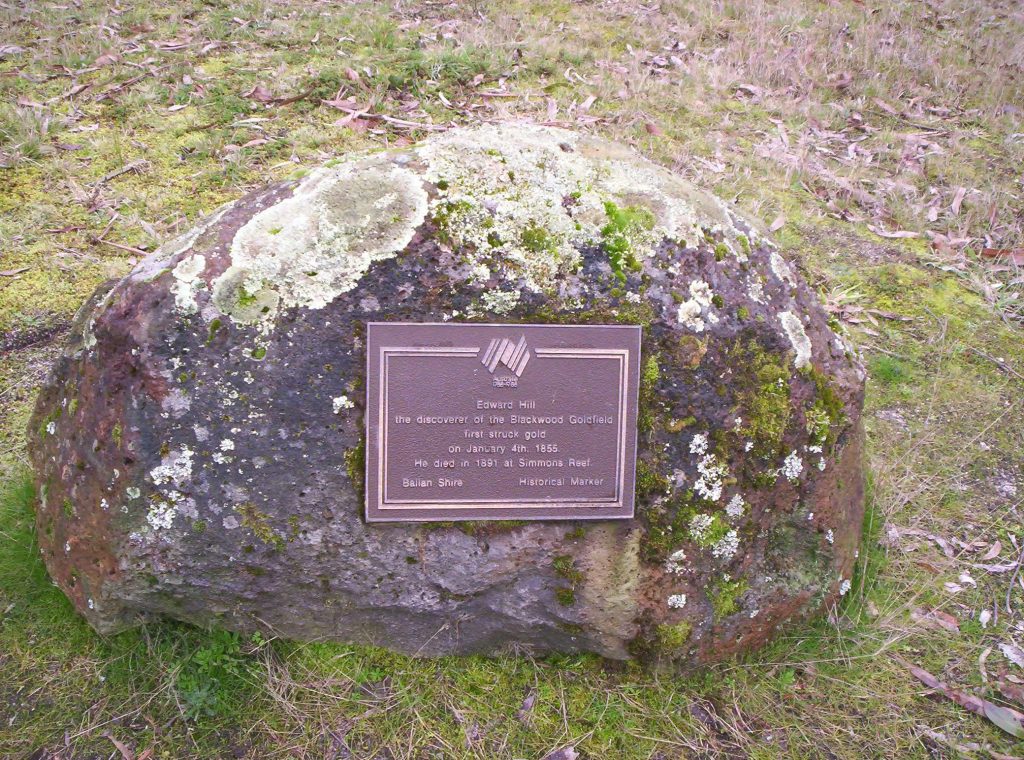
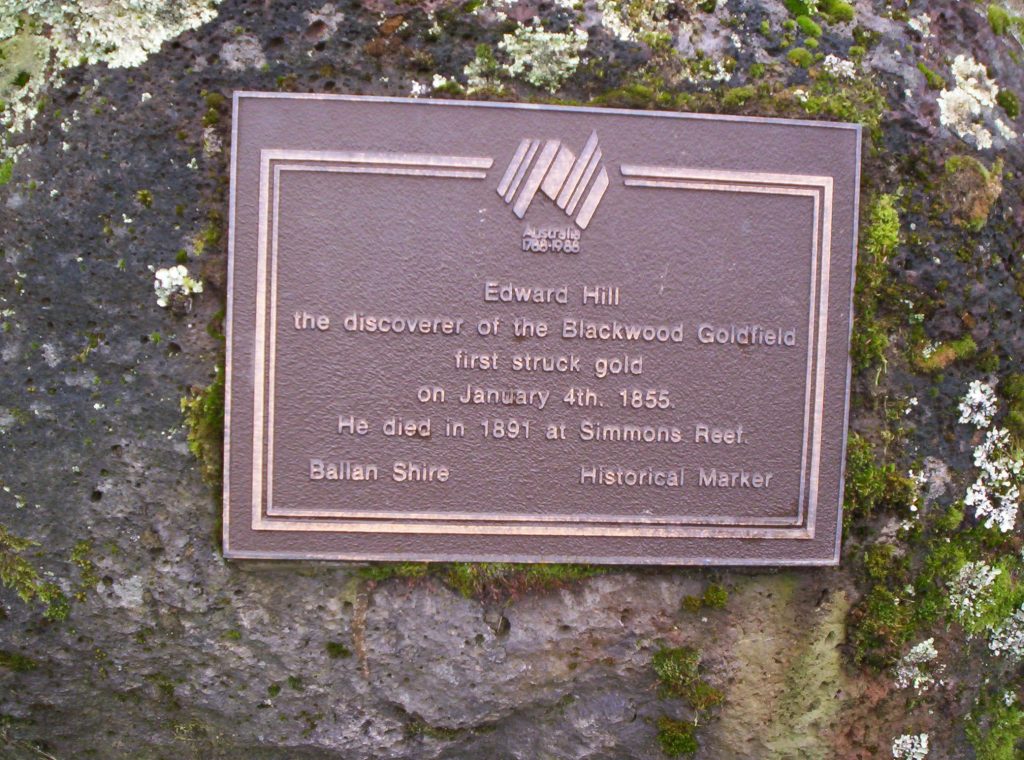
Edward (Ted) Hill discoverer of gold at Hills Tent, Ballan Flat, Blackwood, (Red Hill), Blackwood near the present Sports Ground.
He made mention of two occasions when he took out food and equipment to the original prospectors, whom he knew personally, before the rush took place, and he also told me that, on each of these occasions, there was no-one about save Athorn and Hider’s three prospectors —Jackson, Dungey and Bellinger— and that there was no sign of any prospecting other than theirs having taken place. I was on terms of intimate friendship with Densley, for about 50 years. He was a man of undoubted veracity and probity, and, in addition, was the possessor of a very retentive memory. I am satisfied he was absolutely assured of the truth of what he told me, and, at present, I am of the opinion that his version has the weight of evidence behind it, but I am open to be convinced to the contrary. After all, there is not much difference between him and “G.B.,” and their versions have the appearance of a common origin. As to the name Blackwood. Throughout Brough Smyth’s work, previously referred to, the name Mount Blackwood is applied to the mining settlement; and, in a “Handbook to Australasia,” edited by W. Fairfax, Melbourne, 1859, the same name is used, and its population shown as: 1856, 7,500; 1857, 1,600; 1858, 950; which shows how the population has dwindled in three years.
In the “Victorian Gazetteer,” 1865, published by F. F. Bailliere, Melbourne, the name of the mining settlement is given as Blackwood, and the following statement, inter alia, is made concerning it: The Blackwood diggings were discovered in 1854, and shortly afterwards there -was a great rush to them, the population at that time numbering about 24,000; there has, however, been a great falling off, the population at present not being more than 1,800.” This shows that, between 1858 and 1864, the population of the diggings had materially increased. It would seem that, up to 1859, at anyrate, they were called Mount Blackwood, obviously after the mount of that name to the S.E. of them. Subsequently, possibly for postal reasons, the name was shortened to Blackwood.
JAS. H. WALSH.




